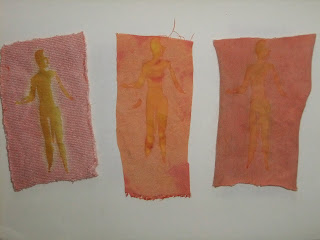

My time spent in my Independent Study Chemistry class has been divided into studying three different processes, the first one being subtractive color. I first dyed 8 pieces of silk with 8 different dye recipes.
1. Myrobalan and Alum Sulfate
2. Osage Orange, Alum, and Lemon Juice (dye bath pH 3)
3. Pomegranate, Alum, and Lemon Juice (dye bath pH 3)
4. Madder, Alum, and Lemon Juice (dye bath pH 3)
5. Madder, Alum, and Soda Ash (dye bath pH 10)
6. Pomegranate, Alum and Soda Ash (dye bath pH 10)
7. Cutch, Alum and Soda Ash (dye bath pH 10)
8. Madder, Cutch, Pomegranate, Alum and Soda Ash (dye bath pH 10)
I choose this as my starting point because I have not come up with a satisfying green dye recipe. By dipping the yellow samples in indigo I might find something I like. I also thought it would be a nice time to experiment with some red and orange samples as well. I am still diping to ket my desired color. The coloring in silk is very illusive, it dries anywhere from 2 to 8 shades lighter than its dipped color. Plus silk which is a protein fiber is not a fan of the alkali indigo bath. The pH changes in the dye bath and the effects that it has on both Cellulose and Protein fibers is what lead me to my next project.













